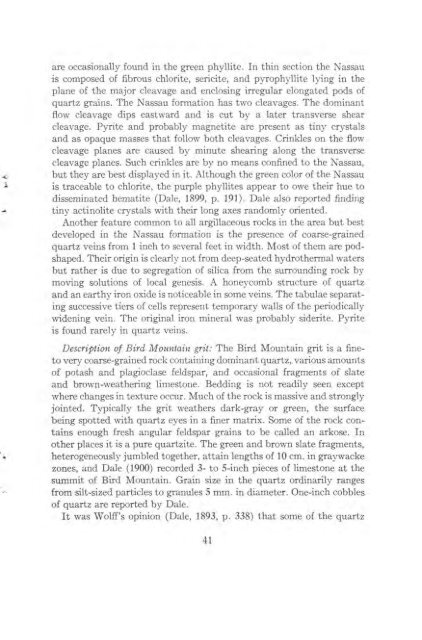STRATIGRAPHY AND STRUCTURE CASTLETON AREA VERMONT
STRATIGRAPHY AND STRUCTURE CASTLETON AREA VERMONT
STRATIGRAPHY AND STRUCTURE CASTLETON AREA VERMONT
You also want an ePaper? Increase the reach of your titles
YUMPU automatically turns print PDFs into web optimized ePapers that Google loves.
are occasionally found in the green phyllite. In thin section the Nassau<br />
is composed of fibrous chlorite, sericite, and pyrophyllite lying in the<br />
plane of the major cleavage and enclosing irregular elongated pods of<br />
quartz grains. The Nassau formation has two cleavages. The dominant<br />
flow cleavage dips eastward and is cut by a later transverse shear<br />
cleavage. Pyrite and probably magnetite are present as tiny crystals<br />
and as opaque masses that follow both cleavages. Crinkles on the flow<br />
cleavage planes are caused by minute shearing along the transverse<br />
cleavage planes. Such crinkles are by no means confined to the Nassau,<br />
but they are best displayed in it. Although the green color of the Nassau<br />
is traceable to chlorite, the purple phyllites appear to owe their hue to<br />
disseminated hematite (Dale, 1899, p. 191). Dale also reported finding<br />
tiny actinolite crystals with their long axes randomly oriented.<br />
Another feature common to all argillaceous rocks in the area but best<br />
developed in the Nassau formation is the presence of coarse-grained<br />
quartz veins from 1 inch to several feet in width. Most of them are podshaped.<br />
Their origin is clearly not from deep-seated hydrothermal waters<br />
but rather is due to segregation of silica from the surrounding rock by<br />
moving solutions of local genesis. A honeycomb structure of quartz<br />
and an earthy iron oxide is noticeable in some veins. The tabulae separating<br />
successive tiers of cells represent temporary walls of the periodically<br />
widening vein. The original iron mineral was probably siderite. Pyrite<br />
is found rarely in quartz veins.<br />
Description of Bird Mountain grit: The Bird Mountain grit is a fineto<br />
very coarse-grained rock containing dominant quartz, various amounts<br />
of potash and plagioclase feldspar, and occasional fragments of slate<br />
and brown-weathering limestone. Bedding is not readily seen except<br />
where changes in texture occur. Much of the rock is massive and strongly<br />
jointed. Typically the grit weathers dark-gray or green, the surface<br />
being spotted with quartz eyes in a finer matrix. Some of the rock contains<br />
enough fresh angular feldspar grains to be called an arkose. In<br />
other places it is a pure quartzite. The green and brown slate fragments,<br />
heterogeneously jumbled together, attain lengths of 10 cm. in graywacke<br />
zones, and Dale (1900) recorded 3- to 5-inch pieces of limestone at the<br />
summit of Bird Mountain. Grain size in the quartz ordinarily ranges<br />
from silt-sized particles to granules 5 mm. in diameter. One-inch cobbles<br />
of quartz are reported by Dale.<br />
It was Wolff's opinion (Dale, 1893, p. 338) that some of the quartz<br />
41













